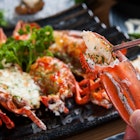
Ten of Australia and New Zealand’s most intriguing wine regions
Sep 28, 2018 • 7 min read

Wine lovers will be no strangers to Australia and New Zealand’s top terroirs, from the Margaret River’s velvety Chardonnays to the aromatic Sauvignon Blancs of Marlborough, New Zealand. But with both countries boasting such diverse terrain – dry craggy plains, verdant valleys and weather-worn plateaus to name a few – there are innumerable under-the-radar and lesser-known wineries worth visiting.
Grab a glass and explore one of these 10 tantalising regions weaving through Australia and New Zealand’s finest wine country.

Canberra, Australian Capital Territory, Australia
Canberra’s cool-climate wine region is one of the nation’s youngest, but what it lacks in maturity, or geographical cohesion, it makes up for in exuberance and a willingness to experiment. You’ll find some of Australia’s most authentic cellar door experiences here, where owners and winemakers loiter eagerly behind counters, excited to offer the incoming punter a sample of their labour.
The Canberra District’s first vines were planted in 1971 at the region’s showcase winery, Clonakilla, in Murrumbateman. John Kirk, Clonakilla’s founder, was among a small group of individuals pivotal to the careful planning and development of the region. They noted that the continental climate, with warm summers accompanied by cool nights and plummeting winter temperatures, provided the perfect conditions for killer Shiraz and crisp, floral Riesling. And from this, another Australian wine region was born.

Hunter Valley, New South Wales, Australia
With age, comes experience. The first vines were planted in the Hunter Valley in the 1860s and today the region is superbly set up for wine tourism, its 110 cellar doors accompanied by excellent restaurants and places to stay, and everything from hot-air-balloon rides to horse-drawn carriage tours. The landscape of lush vineyards framed by the Brokenback Range is picturesque, but it’s the wine – plus the cheese, beer, olives and chocolate – that visitors come to feast on.
Each of the Valley’s seven sub-regions has its own character but most cellar doors are in the central Pokolbin/Rothbury and Lovedale areas. The wineries are a blend of old family estates, such as Tyrrell’s and Mount Pleasant, and modernists including Usher Tinkler and De Iuliis.

Hawke's Bay, North Island, New Zealand
Known as the ‘fruit bowl of New Zealand’, Hawke’s Bay is a patchwork of orchards, vegetable gardens and vineyards, with pasture in between. Alongside such delectable largesse is a raft of attractions ranging from art-deco architecture, farmers’ markets and a sophisticated dining scene, to surf beaches and cycle trails. And as well as being the country’s second largest wine region it’s also the oldest, dating back to 1851 when Marist missionaries planted the first vines between Napier and Hastings.
Full-bodied reds rule the roost across the Bay, particularly the vast plantings of Merlot and Cabernet Sauvignon that lend the region its moniker ‘Bordeaux of New Zealand’. Syrah is also produced in significant volume. The dense, peppery profile of this cooler-climate, Rhône-style red accounts for the locals’ tactical move to eschew the name ‘Shiraz’, thus distinguishing it from the vibrant, jammy Aussie versions.

Granite Belt, Queensland, Australia
Dappling the western flanks of the Great Dividing Range about 210km southwest of Brisbane, the Granite Belt is Queensland’s only real wine region, where hillsides are lined with vineyards, olive groves and orchards growing apples, pears, plums and peaches.
It’s located just north of the New South Wales border in a mountainous area where the 1000m altitude affords Queensland’s coolest grape-growing climate. In 1905 the state government decreed the Granite Belt Queensland’s official health resort on account of its fresh, clean air. The mountainous terrain and high altitude are good news for the vines, too. The soils are predominantly decomposed granite, hence the region’s name, and quite rocky, which favours high-quality wines, especially reds. Mainstream varieties such as Shiraz, Cabernet Sauvignon, Merlot, Chardonnay and Riesling are produced, and a recent new initiative, the StrangeBirds Wine Trail, champions lesser-known types.

Clare Valley, South Australia, Australia
Follow a back-road south out of a town called Clare and a few minutes later you could be sipping from a glass of chilled Riesling on the porch of Skillogalee. Skillogalee is one of around 40 mainly family-run wineries in South Australia’s Clare Valley, an Edenic plateau (not a valley) about two hours’ drive north of Adelaide. Most of the wineries have cellar doors offering tastings and often platters of locally sourced produce, and the welcome at each is as warm as the Australian sun.
Clare, says Skillogalee owner Dave Palmer, is a well-kept secret. Unlike Barossa, the cellar doors don’t have parking spaces for coaches. The region is extremely pretty, with secluded wineries hiding down shady lanes. Not to mention, it’s home to some of the best Riesling in the world.

Langhorne Creek, South Australia, Australia
Langhorne Creek is a somewhat under-appreciated wine region. The region’s grape-growers historically sold most of their grapes to big wineries elsewhere, who often neglected to mention Langhorne Creek as the source. It therefore struggled to muster much of a public profile, unlike the Barossa or Coonawarra. Today, the region has gained recognition for cultivating new varietals and there are more than enough wineries with cellar doors to warrant a weekend trip.
The natural fertility of the region's floodplains, cool maritime climate and moderating effects of winds moving across huge Lake Alexandrina together create conditions in which red varieties thrive. Cabernet Sauvignon is top dog and Shiraz and Merlot can also be very good, but it’s full-bodied, plummy Malbec that has a special affinity.

Marlborough, South Island, New Zealand
Marlborough is a vinous colossus, accounting for around three-quarters of New Zealand’s wine. At last count there were nearly 600 growers tending 23,000 hectares of grapes, working their way into the wines of 151 producers. Remarkably, it has taken just 40-odd years for the Marlborough region to grow from first vines into the billion-dollar industry it is today.
So that’s why you’ve probably heard of Marlborough Sauvignon Blanc; this New World classic is pungently aromatic, fruity and herbaceous, a dominant varietal that has stormed the global wine scene. To home in on memorable Sauvignon Blanc, set your sights on smaller, independent wineries. They are more likely to offer tastings of single-estate wines, not just of Sauvignon Blanc but also of Marlborough’s other notable varietals such as Pinot Noir and Riesling.

Coal River Valley, Tasmania, Australia
Just a short drive northeast out of Hobart, crossing the lofty Tasman Bridge, brings you to the centre of Tasmania’s fastest-growing wine region, the Coal River Valley. Some operations here are sophisticated affairs with gourmet restaurants, others are small, family-owned vineyards with cellar doors open by appointment. While it’s tempting to combine a visit to the Coal with a dip into nearby Derwent Valley wineries, there are enough cellar doors here to warrant a dedicated visit. In fact, this region has the largest concentration of vineyards in southern Tasmania.
Tasmania’s most important grape variety, Pinot Noir, finds itself at home in the Coal River Valley where the mild climate provides near-perfect ripening conditions, although differentiation in climate and soil add interest and variety to the wines.

King Valley, Victoria, Australia
The broad King Valley lies along the Whitfield to Wangaratta road about three hours’ drive northeast of Melbourne. It’s a peaceful part of Victoria: the road runs parallel to the burbling King River, which feeds Lake William Hovell at the southern end of the region.
The story of farming here starts not with wine but tobacco. In the 1850s and ‘60s, the Chinese had started cultivating tobacco in Northeast Victoria to meet demand from incomers drawn by the gold rush. By the 1950s, Italian-born farmers had taken over tobacco production but, as we know, the times were changing and by the early 1980s some of the Italian tobacco growing families – names such as Corsini of La Cantina and Pizzini – had switched to growing grapes, focusing initially on the varieties from back home with which they were most familiar: Sangiovese, Nebbiolo and what is now known as Glera, used to make Prosecco. The distinctively Italian flavour of King Valley has remained ever since.

Margaret River North, Western Australia, Australia
Few wine regions anywhere in the world have rocketed to fame as quickly as Margaret River. It’s never been a secret to Australians that much of the country’s finest wine is made here, and with vast surf beaches, deep forests of tall karri and robust jarrah trees, networks of limestone caves, and pristine air refreshed by its journey across the Indian Ocean from Africa, there’s plenty besides the bottle to waylay visitors.
One of the most geographically isolated wine regions in the world, the Margaret River’s rich gravelly loams cultivate exceptionally high-quality fruit – 3% of Australia’s wine, but 20% of its premium wine, is produced here. Wine critic Jancis Robinson has said: ‘Margaret River is the closest thing to paradise of any wine region I have visited in my extensive search for knowledge.’
Fancy another glass? Take your pick of 40 perfect weekends away in Australia and New Zealand’s wine country with our Wine Trails: Australia & New Zealand guide.
https://shop.lonelyplanet.com/products/wine-trails-australia-new-zealand-1
Explore related stories









